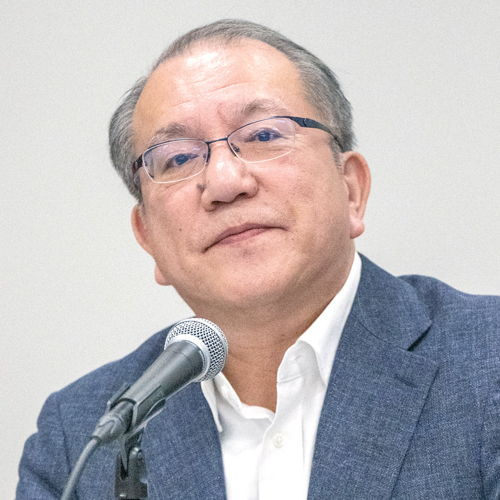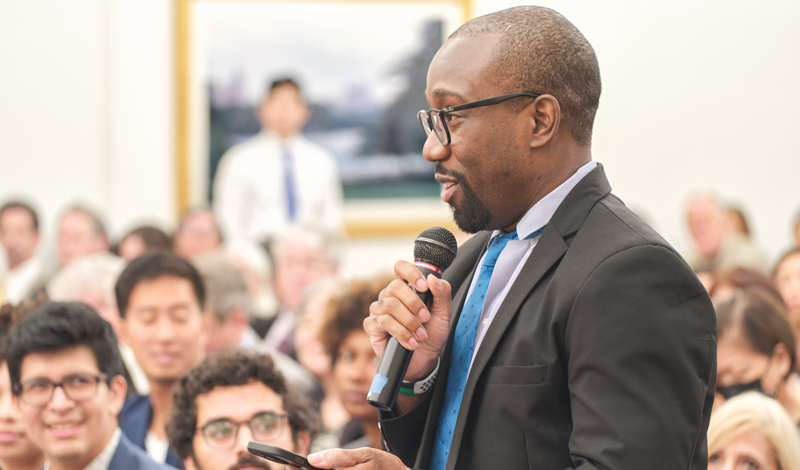SGI Vice President Yoshiki Tanigawa gave the following address at the Tri-state leaders meeting held on Sept. 16, 2024, at the New York Culture Center, New York.

by Yoshiki Tanigawa
SGI Vice President
Thank you for gathering despite this being a weeknight! I understand that representative leaders are here from North Zone, especially from Connecticut and Hudson Valley, New York, and throughout New Jersey, Brooklyn-Queens-Long Island and New York zones! I am thrilled to meet everyone! Thank you very much!
Prayer Is What Powers Our Ability to Win in Everything
During one of his visits to New York, on June 15, 1996, Ikeda Sensei shared guidance here at the New York Culture Center. I’m sure many of you have read and reread this guidance. This is guidance of utmost importance on prayer. He said:
The first thing is to pray. From the moment we begin to pray, things start moving. The darker the night, the closer the dawn. From the moment we chant daimoku with a deep and powerful resolve, the sun begins to rise in our hearts.
Hope—prayer is the sun of hope. To chant daimoku each time we face a problem, overcoming it and elevating our life condition as a result—this is the path of “earthly desires are enlightenment” taught in Nichiren Buddhism.
Suffering and undergoing hardships for the sake of friends and for spreading the Law are manifestations of the great sense of responsibility of a genuine leader and the behavior of a bodhisattva. There is no suffering or hardship that a Bodhisattva of the Earth cannot surmount. So no matter what happens, I would like you to advance steadily, one step at a time, always chanting Nam-myoho-renge-kyo with a vibrant voice.[1]
During his efforts as a youth to lead the historic Kamata Campaign that broke open the barriers of propagation toward achieving second Soka Gakkai President Josei Toda’s goal of having 750,000 households practicing Nichiren Buddhism, Sensei urged the members that everything starts with prayer. In the Osaka Campaign, where they made the impossible possible, the guideline that led them to victory was to have “unparalleled prayer and an unparalleled strategy.” In addition, the first of the five eternal guidelines for the women’s division is “Everything begins with prayer.”
In “A Sage and an Unenlightened Man,” Nichiren Daishonin writes, “While by rights nothing should be beyond the grasp of the Buddha wisdom … the blessings that accrue from accepting and embracing the daimoku of the Lotus Sutra are the one thing that wisdom cannot measure” (The Writings of Nichiren Daishonin, vol. 1, p. 131).
Here, Nichiren teaches that the benefits of chanting daimoku are so vast and beyond comprehension even by the wise Buddha, who is well versed in all things.
Prayer is the power source, the starting point of doing our human revolution, changing our karma and revolutionizing our state of life. The Daishonin says in the same writing:
If you recite these words of the daimoku once, then the Buddha nature of all living beings will be summoned and gather around you. At that time the three bodies of the Dharma nature within you—the Dharma body, the reward body, and the manifested body—will be drawn forth and become manifest. This is called attaining Buddhahood. To illustrate, when a caged bird sings, the many birds flying in the sky all gather around it at once; seeing this, the bird in the cage strives to get out. (WND-1, 131)
When we chant daimoku, we are calling forth the Buddha nature that resides within us. And at the same time, we are reaching the Buddha nature of all those with whom we share connections, and helping their Buddha nature emerge. In other words, it goes without saying that chanting daimoku is the source, the starting point, of victory in expanding and advancing our kosen-rufu movement.
Moreover, Nichiren says: “If you propagate it, devils will arise without fail. If they did not, there would be no way of knowing that this is the correct teaching” (“Letter to the Brothers,” WND-1, 501). Just as he states, when we are engaged in the struggle to advance kosen-rufu and in the struggle to do our human revolution and transform our karma, we are engaged in a head-to-head battle with the devilish functions in our hearts.
Further, the Daishonin says: “Strengthen your faith day by day and month after month. Should you slacken in your resolve even a bit, devils will take advantage” (“On Persecutions Befalling the Sage,” WND-1, 997). He is teaching us that there is no break in this battle with devilish functions. That is why it is vital that we make prayer our foundation. And we do this by doing gongyo and chanting daimoku every single day.
Just as Nichiren says: “Arouse deep faith, and diligently polish your mirror day and night. How should you polish it? Only by chanting Nam-myoho-renge-kyo” (“On Attaining Buddhahood in This Lifetime,” WND-1, 4). We must make steady efforts each day to challenge ourselves in our Buddhist practice.
There may be some youth and future division members who enjoy taking part in Soka Gakkai activities but have a hard time doing gongyo every day.
Sensei offers the following encouragement:
[Doing gongyo] is a daily activity in which we purify and prime our hearts and minds. In the morning, it is starting the engine for our day, like grooming ourselves before we set out for the day.
Some people have powerful engines, and some have weak engines. The strength of the engine dramatically affects what we accomplish throughout the course of our lives. The difference can be enormous. Diligently applying ourselves in our daily practice of [gongyo] boosts the power of our engine. …
Reciting the sutra is a ceremony in which our lives commune with the universe. As we recite the sutra and chant Nam-myoho-renge-kyo, through our faith in the Gohonzon, we vigorously infuse the microcosm of our individual existence with the life force of the macrocosm, of the entire universe. If we do this regularly each morning and evening, our life force—or engine—is strengthened.[2]
He continues:
You can imagine the immense benefit you will obtain when you continue earnestly to [do gongyo] and chant Nam-myoho-renge-kyo morning and evening. Basically, you do both for yourselves. Your practice of reciting the sutra morning and evening and chanting Nam-myoho-renge-kyo is not an obligation—it is a right.
The Gohonzon will never demand that you chant to it. An attitude of appreciation in being able to chant to the Gohonzon is the heart of faith. The more you exert yourselves in faith—in reciting the sutra morning and evening—the more you stand to gain.[3]
So that our successors can gain maximum benefit and live powerfully throughout their lives, let’s take extra care and time to convey to them the importance of doing gongyo and chanting each day.
Creating a Tradition and Model for Raising Youth
During another visit to New York, on May 4, 1967, Sensei warmly offered key guidance on how to raise and nurture youth. This is outlined in The New Human Revolution, vol. 12, “Fresh Hope” chapter as follows:
I am reassured to hear that the youth are developing in New York as well. No matter how dynamic and solid an organization appears to be, if its youth are not growing, it will eventually stagnate. Fostering young people is crucial to the achievement of kosen-rufu.[4]
And when asked about the key to raising the younger generation, Sensei responded:
We must trust and respect youth. … We need to be firmly determined to support them in becoming even more capable than ourselves, empowering them to fully develop their potential. …
We need to help them gain a thorough understanding of the basic thinking and behavior of a leader of kosen-rufu. …
In fostering youth we need to entrust them with specific assignments and give them opportunities to take the lead. …
Inspire them to use their hardships as a springboard for deepening their faith.[5]
Concluding these points, he said, “At any rate, what matters is that we look after the youth as if they were our younger siblings.”[6]
Many incredibly capable leaders throughout the U.S. have come from New York, having earnestly fought for kosen-rufu and grew in faith here, and then moved to other places. To me, this is proof that you have cherished and applied Sensei’s guidances given to members in New York.
Now we have entered a time when raising capable youth is absolutely crucial. I would like to see the zones in and around New York further establish a grand tradition for being the model for warmly raising young people. Can I ask you to do this?
Two months from now, we will mark the memorial of Ikeda Sensei’s passing on Nov. 15, and we will commemorate the Soka Gakkai’s founding on Nov. 18. I understand that SGI-USA’s goal for the November District General Meetings is to have 50,000 people attend these meetings. Starting with all of us gathered here today, toward November, let’s begin with fresh resolve to repay our gratitude to Sensei and fight and win as his disciples!
October 11, 2024, World Tribune, pp. 8–9
You are reading {{ meterCount }} of {{ meterMax }} free premium articles

